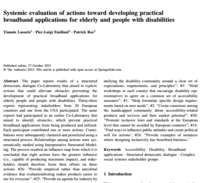Systemic evaluation of actions toward developing practical broadband applications for elderly and people with disabilities
|
Abstract
The paper reports results of a structured democratic dialogue Co-Laboratory that aimed to explore actions that could alleviate obstacles preventing the development of practical broadband applications for elderly people and people with disabilities. Thirty-three experts representing stakeholders from 20 European countries and one from the USA participated. The same experts had participated in an earlier Co-Laboratory that aimed to identify obstacles, which prevent practical broadband applications from being produced and utilized. Each participant contributed one or more actions. Contributions were subsequently clustered and prioritized using a structured process. Relationships among actions were systematically studied using Interpretative Structured Modeling. The process resulted an influence map from which it is concluded that eight actions have the greatest influence (i.e., capable of producing maximum impact), and stakeholders should therefore focus their efforts on these actions: #26: ‘‘Provide empirical rather than anecdotal evidence that evaluation/testing makes products easier to use for everyone’’; #25: ‘‘Provide an agenda for industry by unifying the disability community around a clear set of expectations, requirements, and principles’’; #3: ‘‘Hold workshops in each country that encourage disability representatives to agree on a common set of accessibility measures’’; #1: ‘‘Help formulate specific design requirements based on user needs’’; #2: ‘‘Create consensus among the handicapped community about accessibility-related products and services and their market potential’’; #20: ‘‘Promote inclusive laws and standards at the European level that cannot be avoided by European countries’’; #14: ‘‘Find ways to influence public attitudes and create political will for actions’; #24: ‘‘Provide examples of instances where designing inclusively has benefitted business.’’
Citation
Elena, A., Laouris, Y., & Taraszow, T. (2010). Identifying and ranking internet dangers. SALL 2010, 68.
